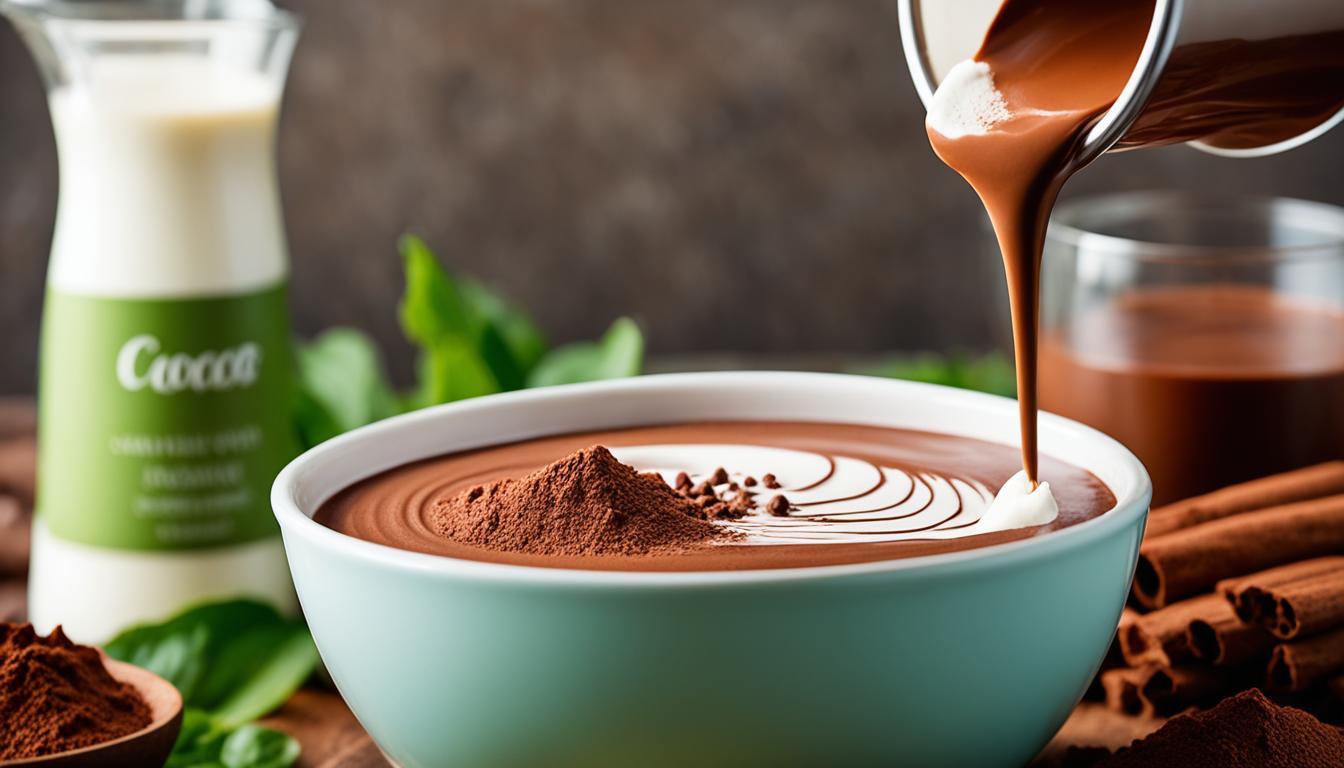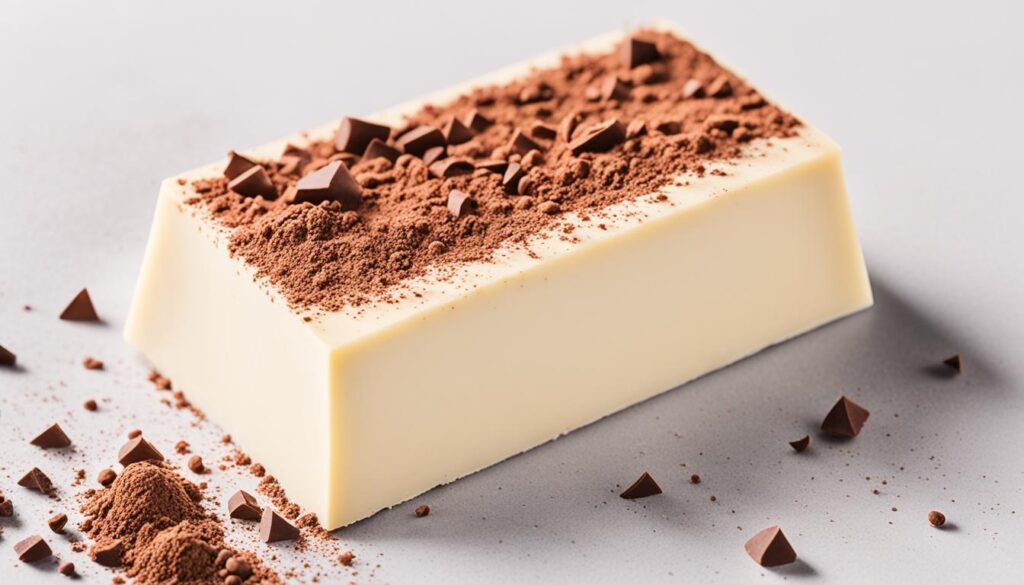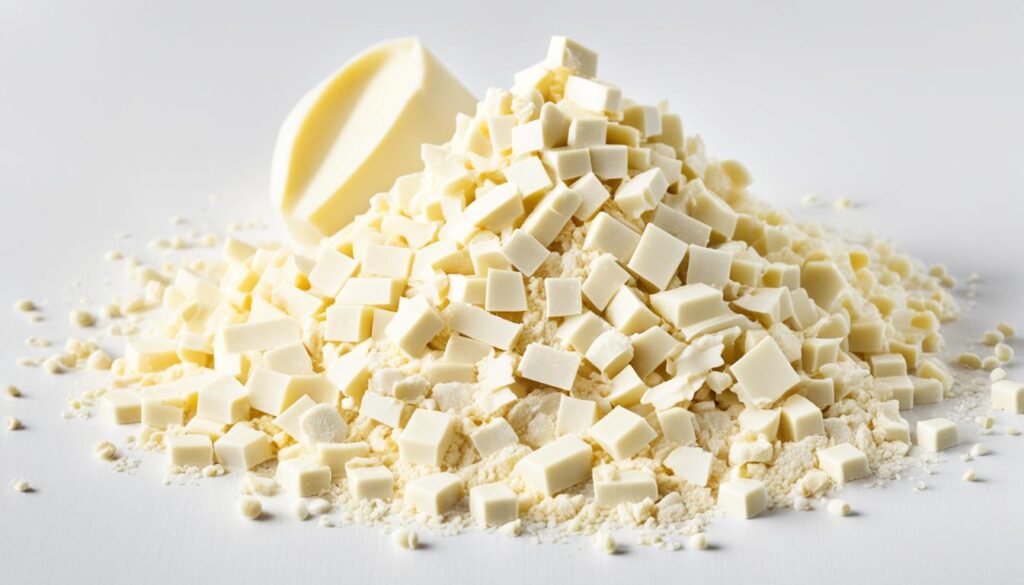Watching delicate snowflakes fall, I’m reminded of white chocolate’s magic. In my kitchen, I explore its mystery. Many say it’s not real chocolate, but to me, it’s comfort in a bite. The blend of cocoa butter, sugars, and milk tells the secret of white chocolate.
Enjoying white chocolate is a joyful journey. Each piece, smooth and creamy, is pure happiness. The story starts in 1936 with Nestlé’s invention1. True white chocolate has over 20% cocoa butter and rich milk solids1. A small piece has about 15 to 20 grams of sugar2. It’s a blend of the beauty of sugarcane, beets, and the smoothness of powdered sugar.
Key Takeaways:
- White chocolate’s sweetness is defined by cocoa butter and sugar content.
- Recipes vary, but true white chocolate always includes milk solids.
- Quality and flavor demand adherence to established white chocolate ingredients ratios.
- The process from cocoa butter selection to the final product is critical.
- Balancing the ingredients ensures that white chocolate retains its creamy texture.
The Unique Composition of White Chocolate
I find white chocolate’s uniqueness captivating. Its creaminess comes from cocoa butter, not cocoa solids. This makes it soft and smooth, unlike dark or milk chocolate.
Let’s explore the unique charm of white chocolate. Its secret? White chocolate cocoa butter. This special ingredient gives it a soft texture and a sweet flavor23.
The Absence of Cocoa Solids
Dark and milk chocolates get their taste from cocoa solids. But not white chocolate. Because it lacks cocoa solids, its flavor is creamier and sweeter. Even though it doesn’t have the same health perks as dark chocolate24, white chocolate has its own rich taste.
Cocoa Butter: The Core Ingredient
The star of white chocolate is white chocolate cocoa butter. This gives it a rich feel and a slight cocoa taste23. The FDA says white chocolate needs at least 20% cocoa butter. This is why it melts so nicely in your mouth34.
White chocolate milk powder also plays a part. It makes the chocolate creamier. Plus, it adds protein and calcium2.
Reflecting on white chocolate, its appeal lies in the balance. It combines milky creaminess with a taste of vanilla. This blend is both comforting and luxurious.
Decoding the Ingredients: What Makes White Chocolate
Exploring how to make white chocolate is truly interesting. The key ingredient, cocoa butter, makes up at least 20% of its mix5. This gives white chocolate its smooth feel and rich taste5. Let’s dive deeper into this topic.
Exploring Cocoa Butter’s Role
Cocoa butter is the essence of white chocolate’s unique texture. It has no cocoa solids, unlike dark chocolate5. The fat makes up 26-35% of the total, balancing creaminess and sweetness perfectly5.
The Sweetness Factor: Types of Sugar Used
The sugar in white chocolate’s milky flavor is key. I can use granulated or powdered sugar, and each one changes the sweetness. This shows how adaptable white chocolate can be in recipes5.
Milk Solids: Contributing to Creaminess
Milk solids make up at least 14% of white chocolate5. They add a rich, creamy taste and pair well with the vanilla often found in recipes5. This mix makes white chocolate a comforting, luxurious treat.
| Ingredient | Contribution to White Chocolate | Content Requirement |
|---|---|---|
| Cocoa Butter | Texture and Creaminess | Minimum 20%5 |
| Sugar (Granulated/Powdered) | Sweetness | Varies by Recipe |
| Milk Solids | Creaminess and Milky Flavor | Minimum 14%5 |
Knowing how cocoa butter, white chocolate sugar types, and milk solids work together is crucial for making this treat. Each element not only adds to the flavor but also makes creating white chocolate an art form.
Delving into White Chocolate’s Sweetness
I love everything sweet and white chocolate is a top favorite. It’s smooth and creamy because it doesn’t have cocoa solids. Instead, it has cocoa butter, sugar, and milk6. White chocolate is different from dark chocolate. Dark chocolate is less sweet because it has more than 55% cocoa7.
Let’s dive into the sweet world of white chocolate. Getting the right flavor in white chocolate is all about managing sugar8. Sugar makes our brains happy, which is why we love this melt-in-your-mouth treat8.
Understanding Sugar’s Impact on Flavor
White chocolate is the sweetest type of chocolate. It’s made without cocoa solids, and it’s rich in cocoa butter, milk, and sugar7. Making white chocolate is tough. Chocolate makers have to avoid making it too sweet. They are getting creative with flavors to keep us excited6.
How to Balance Sweetness in White Chocolate
Perfecting white chocolate flavor is like making music. It takes skill to blend sugar and other tastes together. Experts suggest pairing white chocolate with light wines. Wines like Beaujolais or Pinot Noir can balance the sweet and creamy taste7.
To mix things up, add ingredients that contrast with the sweetness. Think of adding a bit of tartness or spice. The white chocolate world is growing. There are many new tasty types to try6.
| Chocolate Type | Main Ingredients | Recommended Pairings |
|---|---|---|
| White Chocolate | Cocoa Butter, Milk, Sugar | Beaujolais, Pinot Noir, Riesling7 |
| Milk Chocolate | Smooth Red Wines like Merlot, Rioja7 | |
| Dark Chocolate | > 55% Cocoa Solids | Port-Stlyed Reds like Malbec, Zinfandel7 |
When we enjoy white chocolate, there’s a lot happening in our mouths. Theobromine gives us a gentle buzz. It’s a bit like caffeine. This makes the sweet flavor of white chocolate even more special. It tastes so good and stays with us just long enough8.
Vanilla Flavor: Enhancing the White Chocolate Experience
Exploring white chocolate, we see vanilla’s key role. It brings out sweet flavors that match white chocolate’s creamy feel. This perfect pair shows the skill of chocolatiers and the taste of those who love chocolate.
The Role of Vanilla in Taste and Aroma
White chocolate is all about luxury. Adding white chocolate vanilla flavor is like the cherry on top. Vanilla does more than taste good; its smell makes white chocolate seem richer and sweeter. It makes sure the sweetness is just right, giving a deep flavor experience.
Different Forms of Vanilla Used in White Chocolate
Vanilla comes in many types, like rich Madagascar Bourbon or fruity Tahitian. Chocolatiers pick the right vanilla form for their creations. This could be whole beans, extract, or paste. Each adds a special touch. Even at home, using vanilla can make your white chocolate taste professional.
| Vanilla Form | Characteristics | Common Use in White Chocolate |
|---|---|---|
| Vanilla Extract | Concentrated flavor, easy to mix | Adding nuanced aroma to batter and ganache |
| Vanilla Bean | Rich, full-bodied flavor with visible specks | Infusing white chocolate bars and gourmet desserts |
| Vanilla Paste | Sweet intensity, thick consistency | Crafting luxurious frosting and fillings |
When making white chocolate, following quality rules is important. The FDA demands certain amounts of cocoa butter and milk solids3. Europe’s standards are also high. These rules highlight the need for top-notch ingredients, including vanilla, for the best white chocolate.
Considering this, white chocolate’s flexibility shines. It works well with vanilla in various recipes. Next time, think about how vanilla lifts up the white chocolate’s taste. This makes every piece or homemade treat unforgettable and enticing.
The Essence of Creaminess: Milk Solids in White Chocolate
If you love sweets, you’ll find it interesting how milk solids make white chocolate so creamy. These solids are key to the taste and feel of white chocolate. They match perfectly with the sweet taste from other ingredients9.
In 2022, white chocolate made up about 10 percent of the chocolate market. Its special makeup sets it apart1. In the EU and US, laws say white chocolate must have at least 20 percent cocoa butter and 14 percent milk solids. Often, it has even more than 30 percent milk solids, which is more than milk chocolate19.
People love white chocolate’s creamy feel. This comes from strict rules about how much white chocolate milk powder it should have. This ingredient gives a smooth and rich taste. Milk solids also add good nutrition, like protein and calcium, which are important for your health1.
- EU White Chocolate Regulations: at least 20% cocoa butter, 14% milk solids, 3.5% milk fat.
- US FDA Standards: a minimum of 20% cacao fat, 14% total milk solids, 3.5% milk fat.
- Nutritional Value: High in milk solids, providing protein and calcium for dietary needs.
Vegan options for white chocolate are now being made too. They use cocoa butter, coconut oil, and different sweeteners. These mimic the creamy texture white chocolate is known for1.
Every piece of white chocolate, no matter if it’s chips or bars, shows the perfect mix of sweet and creamy from the milk solids. As companies create vegan choices, everyone gets to enjoy white chocolate. It stays true to its original taste but also fits with what people want today.
What Is White Chocolate Made With: The Role of Emulsifiers
Understanding the makeup of white chocolate shows us the importance of each ingredient. One key part often missed is the emulsifiers. Lecithin, for instance, plays a huge role in making white chocolate smooth and delicious.
Emulsifiers like lecithin work by mixing cocoa butter fat with milk solids’ water. They make sure the mix is even. This lets the white chocolate melt smoothly in your mouth, giving a consistent taste. Lecithin isn’t just for stability; it enhances the joy we get from each bite.
Although lecithin doesn’t add many nutrients or calories, its job in keeping texture and structure is key. It’s an unseen star in sweets making.
Lecithin: The Invisible Hero of Consistency
Lecithin helps keep the quality of white chocolate high but is often unnoticed. It stops cocoa butter and milk solids from separating. This helps to make the white chocolate’s texture smooth to enjoy.
White chocolate needs at least 20 percent cocoa butter, 14 percent milk solids, 3.5 percent milkfat, and no more than 55 percent sweeteners10. Lecithin quietly blends these ingredients. It balances the rich taste with creaminess. It meets standards in the U.S., Canada, the EU, and the Codex Alimentarius Commission, ensuring international quality10.
The rules for making white chocolate show its importance. The FDA got six supports from chocolate companies for a white chocolate standard10. Lecithin helps these products easily meet market standards. It fits with over 280 existing standards, unlike the few for common names10.
Lecithin is key not only in making white chocolate but also in its shelf life. It reduces the Maillard reaction, which can cause off-flavors and browning11. It keeps ingredients balanced, stops fats from going bad, and helps white chocolate look and taste great11.
Even though you can’t see lecithin in white chocolate, it’s there. It makes sure flavors blend well and the texture is smooth. Without it, white chocolate wouldn’t have the quality we love. It turns it into a culinary masterpiece.
White Chocolate: A Comparison with Dark and Milk Variants
Diving into chocolates, I find the variety fascinating. I love comparing white, milk, and dark chocolate. It’s not just the taste but the nutritional value white vs dark chocolate and texture that matter.
The Nutritional Perspective of White vs. Dark Chocolate
White chocolate’s magic is in its cocoa butter, offering a creamy delight12. Milk chocolate stands out too; it combines cocoa, milk, and sugar for that classic taste12. Dark chocolate, rich in cocoa, brings health perks like heart disease prevention with its intense flavor12.
Choosing dark chocolate means opting for health. I go for ones with at least 70% cocoa. They have more healthful flavanols and less sugar than light chocolates12.
Taste and Texture Differences
White chocolate is uniquely sweet and creamy. Its taste is light, missing the deep tones of dark chocolate12. Dark chocolate, though, is a complex treat. It combines bitterness and natural sweetness12.
I love the rich taste of dark chocolate as it melts, offering a burst of flavonoids13. Milk chocolate recalls its smooth, vanilla-infused origins, blending cocoa butter and milk for smoothness13.
Here’s a direct white chocolate taste comparison:
| Chocolate Type | Cocoa Content | Main Ingredients | Calorie Count (per ounce) | Health Benefit |
|---|---|---|---|---|
| Dark Chocolate | 50-90% | Cocoa solids, cocoa butter, sugar | 150-170 | May reduce heart disease risk12 |
| Milk Chocolate | 10-50% | Cocoa solids, cocoa butter, milk, sugar | Varies | – |
| White Chocolate | 0% (No cocoa solids) | Cocoa butter, sugar, milk14 | Varies | – |
Whether it’s white chocolate’s creamy taste or dark chocolate’s rich benefits, knowing the differences makes eating them better. White chocolate might not win in health benefits, but its taste is still worth enjoying now and then.
The Technique Behind Crafting White Chocolate
I’ve always loved the detailed process behind making white chocolate. This treat is special because of its creamy cocoa butter, which melts just right. In the U.S., real white chocolate must have at least 20 percent cocoa butter. This gives it that smooth, rich taste15.
From Roasting to Tempering: Process Overview
Making white chocolate begins with picking the best ingredients, especially high-quality cocoa butter. The roasting and winnowing steps start the flavor journey. Conching then smooths the mix. Nestle’s Alpine White bar shows how getting this mix right leads to a hit product16.
After that comes tempering the chocolate. This step involves careful temperature control. It ensures the cocoa butter crystals are stable. This gives the chocolate its nice snap and shiny look. Without tempering, the chocolate might look and feel off.
The Art of Cooling and Molding
Then, we mold the chocolate. Here, the tempered chocolate gets shaped in molds. Cooling follows, setting the chocolate into its final form. If not handled right, the chocolate can get blooms. These are whitish streaks or spots that ruin the look.
Top brands like Godiva and Harbor Sweets excel in this art. Godiva’s Ivory White bars and Harbour’s Sweet Sloop have seen sales grow thanks to masterful crafting. With unique products like white-chocolate toothpaste and tortellini, precision in molding is crucial16.
For any creator, the joy is in the process as much as the final product. White chocolate is no exception. Though it lacks cocoa solids, it’s rich in flavor. This turns cocoa butter, sugar, and milk into a beloved form of chocolate art15.
Embracing the Sweetness: The Story of White Chocolate
I often explore the world of tasty treats, finding myself drawn to white chocolate’s creamy taste. It has a rich history, as complex as its flavor. The journey of white chocolate is a tale of creativity, where top-notch ingredients like cocoa butter, milk solids, and sugar blend perfectly. Nestle’s Alpine White bar became a hit, only beaten by their Crunch bar, showing its broad appeal16. Others, like Harbor Sweets, built their reputation on unique white chocolate products, proving its lasting charm16.
Thinking about white chocolate’s impact, it’s global. European pastry chefs and American ’80s cookbooks have fully embraced it with recipes like hazelnut cheesecake17. Hershey’s production of Hugs kisses highlights white chocolate’s importance in sweets. Seeing how brands innovate with white chocolate makes me proud18.
I love trying white chocolate in various forms, from home recipes to artisan treats. Over time, it has evolved fascinatingly. Thanks to the FDA, today’s chocolate meets high quality and purity standards, offering us a richer taste. Each bite of this treat is a journey of taste, craftsmanship, and lingering sweetness.
FAQ
What is white chocolate made with?
White chocolate contains cocoa butter, sugar, and milk solids. It lacks cocoa solids, making it different from milk and dark chocolate.
Why does white chocolate lack the chocolatey flavor of dark chocolate?
White chocolate doesn’t have the cocoa solids that give dark chocolate its taste. Instead, it has a creamy, sweet taste from cocoa butter, sugar, and milk solids.
What is cocoa butter’s role in white chocolate?
In white chocolate, cocoa butter creates a creamy texture. It acts as a binder for sugar and milk solids, adding a slight cocoa flavor.
What types of sugar are used in white chocolate?
Granulated white or powdered sugar make white chocolate sweet and smooth. The sugar balances the flavors of the other ingredients.
How do milk solids contribute to white chocolate’s creaminess?
Milk solids add a creamy, dairy flavor to white chocolate. They improve the chocolate’s texture and nutritional value.
How can you balance the sweetness in white chocolate?
To balance sweetness, the sugar amount and type are carefully chosen. Vanilla, cocoa butter, and milk solids are also important for flavor.
What role does vanilla play in white chocolate?
Vanilla improves white chocolate’s creamy, sweet flavors. It helps mask any overly sweet or fatty tastes, enhancing the overall flavor.
Why are emulsifiers like lecithin used in white chocolate?
Lecithin keeps cocoa butter and other ingredients smoothly mixed. It stops them from separating, giving uniform texture to white chocolate.
How does the taste and nutritional value of white chocolate compare with dark chocolate?
Dark chocolate, rich in flavor and antioxidants, is different from white chocolate. White chocolate has a sweeter, creamy taste but less nutritional benefits.
What’s the process of making white chocolate?
Making white chocolate involves picking quality ingredients, roasting cocoa butter, and mixing it with sugar and milk solids. It is then tempered and molded into shape.
How do most people enjoy white chocolate?
People use white chocolate in baking and cooking. It’s popular in cakes, cookies, or by itself for its sweet, creamy taste.



